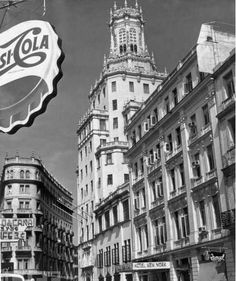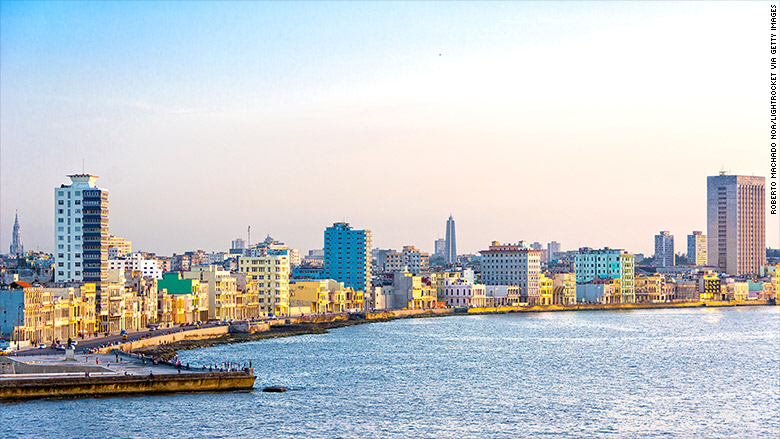BEFORE, WAS THE LUXURIOUS ‘HOTEL NEW YORK’, HAVANA, CUBA. TODAY ABANDONED TO DESTRUCTION.
The sumptuous “Hotel New York”, in the street of Dragones between Amistad and Aguila. Located in a position very close to the railway Terminal, and enviable, next to the gate that marks the entrance to Chinatown, a few meters from the National Capitol, undoubtedly, was for many decades the hotel which housed the Cuban province, visiting the capital and many of the tourists who were visiting Havana.
Built by Cubans contractors Tella and Cueto, inaugurated on June 18, 1920. Owner white Lopez and company, owned also Boston and Saratoga hotels.
At the beginning of the 20th century the possibilities of accommodation in Havana were reduced and the usual was staying in guest houses. With the establishment of the new Republic and American intervention, was given a great migratory movement, which led to a high demand for facilities for the accommodation of traders, businessmen and tourists. Existing facilities, with amenities such as elevators and installation of bathrooms and toilets in the rooms were modernized then.
During the first World War (time of the ¨Vacas Gordas¨) again increased the demands of hotel capacities in Havana and fashion a project was ¨tipico¨ of four or five-story buildings, with rooms distributed around a central courtyard usually covered.
In the Netherlands the reception, lobby, bar, stood offices of the Administration and other public services. The intermediate floors were dedicated to rooms, all with bathroom, cold and hot water, phone (sometimes only one per floor) and other advancements of the time. New York had 87 rooms. The dining room was located on the top floor. The facade consisted of three rows of windows with balconies.
The press of the time includes that you settled a luxurious furnishings and an elegant restaurant on the ground floor, in the style of the great U.S. hotels.
Today, no one is welcome to the HOTEL NEW YORK.
Today the roots of a shrub have grown between the steps and the weed extends over the porch. The New York hotel, a few meters from the Capitol of Havana, is the living image of abandonment. More than one decade its doors closed to the public, and since then it doesn’t sound the Orchestra Music, the Chin-Chin of the cups or soft sliding of the wheels of a suitcase. It seems a big Apple recessed and rotten at the heart of the city.
Until a few years ago lyrics of metal indicated to passersby that at the Dragones Street, between friendship and Eagle, is made an accommodation with an international air whose construction was completed in 1919. The building was originally owned by José H. Martínez, a wealthy landowner who spared no expense in its design.
That story can barely be glimpsed in the ruins that remain, although some of the lost glamour stays in the mind of the oldest residents. Eduardo, a retiree who teaches his “fighter” meat, proudly resides in the area since 1959. It has that, when they closed the hotel at the end of the last century, “many were that took parts of bath and even tiles”. According to the old man, it was for that reason that the authorities in the area “tapiaron all entries with cement and blocks”. But the raids have followed and now “this has become a public bath”. Just it is a blind, metal railings surrounding the Interior balconies have been grubbed up and or a single crystal of which surround the door stays in place.
At the entrance, sunk into the soil of granite that has resisted the apathy, just read the initials of the New York. Full name, protruding in the middle of the dirt is also maintained in some steps of the stately entrance.
The facade, which has continued to be impressive despite the deterioration, has four rows of windows and separate balconies. A touch of greatness printed you five large Corinthian pilasters attached to the outer wall and a large ledge on which is built the fourth level when the extension of the building in 1919. The whole place has been as a small scale of its cousins giants of Manhattan model.
For many months in all the meetings of accountability of the area, neighbors pose that the building has become a focus of disease and a health hazard. Nothing to do flutter to the delegate of the Popular power of an area full of properties on the verge of falling.
Scattered around the city, objects that formed part of the New York adorn the Hall of an apartment, are resold in the informal market or go to waste. An old custodian of the place keeps a partition and an old pendulum clock that says having saved from looting. “One day, when they reopen the hotel, I’ll return them”, he says with a mischievous smile, but now no one believes that music will once again sound within these walls.
Agencies/14ymedio/Luz Escobar, Havana/InternetPhotos/Cibercuba.
THE CUBAN HISTORY, HOLLYWOOD.
Arnold Varona, Editor.
ANTES, FUE EL LUJOSO ‘HOTEL NEW YORK’, HABANA, CUBA. HOY, ABANDONADO A SU DESTRUCCIÓN.
El suntuoso Hotel New York, en la calle Dragones entre Amistad y Águila. Ubicado, sin dudas, en una posición envidiable, junto a la puerta que marca la entrada al Barrio Chino, a pocos metros del Capitolio Nacional y muy cercano a la Terminal de Ferrocarriles, fue durante muchas décadas el hotel que acogía a los cubanos de provincia, de visita por la capital y muchos de los turistas que visitaban la Habana.
Construido por los contratistas cubanos Tella y Cueto, se inauguró el 18 de junio de 1920. Su propietario Blanco López y Compañía, era dueño también de los hoteles Boston y Saratoga.
A inicios del siglo XX las posibilidades de alojamiento en La Habana eran reducidas y lo usual era hospedarse en casas de huéspedes. Con la instauración de la nueva república y la intervención norteamericana, se dio un gran movimiento migratorio, que provocó una elevada demanda de instalaciones para el alojamiento de comerciantes, hombres de negocio y turistas. Se modernizaron entonces las instalaciones existentes, con comodidades como ascensores y la instalación de baños y servicios sanitarios en las habitaciones.
Durante la Primera Guerra Mundial (época de las ¨Vacas Gordas¨) nuevamente se incrementaron las demandas de las capacidades hoteleras en La Habana y se puso de moda un proyecto ¨típico¨ de edificios de cuatro o cinco pisos de altura, con los dormitorios distribuidos alrededor de un patio central, generalmente cubierto.
En los bajos se ubicaba la recepción, el lobby, bar, oficinas de la administración y otros servicios públicos. Los pisos intermedios se dedicaban a habitaciones, todas con su baño, agua fría y caliente, teléfono (a veces sólo uno por piso) y otros adelantos de la época. El New York contaba con 87 habitaciones. El comedor se ubicaba en la última planta. La fachada se componía de tres filas de ventanas con balconcillos.
La prensa de la época recoge que se colocó un lujoso mobiliario y un elegante restaurante en la planta baja, al estilo de los grandes hoteles estadounidenses.
HOY, EN EL 2016 NADIE ES BIENVENIDO AL HOTEL NEW YORK.
Hoy las raíces de un arbusto han crecido entre los escalones y la maleza se extiende sobre la marquesina. El hotel New York, a pocos metros del Capitolio de La Habana, es la viva estampa del abandono. Hace más de una década sus puertas cerraron al público y desde entonces no suena la música de la orquesta, el chin-chin de las copas o el suave deslizamiento de las ruedas de una maleta. Parece una Gran Manzana ahuecada y podrida en el corazón de la ciudad.
Hasta hace pocos años unas letras de metal indicaban a los transeúntes que en la calle Dragones, entre Amistad y Águila, se erigía un alojamiento con aires internacionales cuya construcción concluyó en 1919. El edificio fue originalmente propiedad de José H. Martínez, un rico hacendado que no escatimó gastos en su diseño.
Esa historia apenas puede entreverse en las ruinas que quedan, aunque algo del perdido glamour se mantiene en la mente de los vecinos más antiguos. Eduardo, un jubilado que enseña con orgullo su carné de “combatiente”, reside en la zona desde 1959. Cuenta que, cuando cerraron el hotel a finales del siglo pasado, “eran muchos los que se llevaban las piezas de baño y hasta los azulejos”. Según el anciano, fue por esa razón que las autoridades de la zona “tapiaron todas las entradas con cemento y bloques”. Pero las incursiones han seguido y ahora “esto se ha convertido en un baño público”. Apenas queda una persiana, las barandas de metal que rodeaban los balcones interiores han sido arrancadas y ni un solo cristal de los que coronaban las puertas se mantiene en su lugar.
A la entrada, hundidas en el suelo de granito que ha resistido la desidia, apenas se pueden leer las iniciales del New York. En algunos escalones de la señorial entrada también se mantiene el nombre completo, que resalta en medio de la mugre.
La fachada, que no ha dejado de ser imponente a pesar del deterioro, tiene cuatro filas de ventanas y balconcitos independientes. Un toque de grandeza le imprimen las cinco grandes pilastras corintias adosadas al muro exterior y una gran cornisa sobre la que se construyó el cuarto nivel cuando la ampliación del edificio en 1919. Todo el lugar viene siendo como un modelo a escala pequeña de sus primos gigantes de Manhattan.
Durante muchos meses en todas las reuniones de rendición de cuenta de la zona, los vecinos plantean que el edificio se ha convertido en un foco de enfermedades y un peligro para la salud. Nada que haga pestañear al delegado del Poder Popular de una zona llena de inmuebles a punto de caerse.
Desperdigados por la ciudad, los objetos que formaron parte del New York adornan la sala de un apartamento, son revendidos en el mercado informal o van a parar a la basura. Un viejo custodio del lugar guarda una mampara y un antiguo reloj de péndulo que dice haber salvado del saqueo. “Un día, cuando reabran el hotel, los devolveré”, asegura con una maliciosa sonrisa, pero ya nadie cree que la música volverá a sonar entre esas paredes.
Agencies/14ymedio/Luz Escobar, La Habana/InternetPhotos/Cibercuba.
THE CUBAN HISTORY, HOLLYWOOD.
Arnoldo Varona, Editor.







